
The taking of Goldstein: how social media helped tip the balance in favour of challenger Zoe Daniel
Ousted Liberal MP Tim Wilson was comprehensively outmanoeuvred by his independent opponent Zoe Daniel’s social media campaign strategy. While Mr Wilson relied on static Liberal Party messaging, Ms Daniel directly engaged with younger voters. FactLab analyzes the starkly different approaches in the hotly contested Melbourne seat of Goldstein.
Triumphant independent Zoe Daniel ran a highly organised social media campaign throughout the election, using powerful video messaging to tap into voter dissatisfaction with the Morrison government’s record on issues such as climate change and gender equality, while advocating for change.
A FactLab analysis found the former broadcast journalist and her team galvanised younger voters in the south-east Melbourne electorate of Goldstein through her “Gen Zoe” movement, which directly targeted people aged between 18 and 34 who make up almost one-fifth of Goldstein’s population. Many were recruited as volunteers to support her campaign.
Ousted Liberal MP Tim Wilson, on the other hand, relied heavily on content from the Liberal Party and News Corporation media for his social media push, a strategy which failed to generate significant positive user engagement.
The electorate
The electorate of Goldstein, which had been held by the Liberal Party since its creation in 1984, lies in the bayside suburbs of Melbourne, and is home to more than 158, 000 people. Named after suffragist Vida Goldstein, one of the first women to stand for federal parliament, the electorate’s gender makeup stands at roughly 48 per cent male and 52 per cent female.
People aged between 35 and 49 represent the largest age group, accounting for 21.1 percent of the population.
Goldstein’s younger generation, those aged between 18 and 34, represent 19.2 percent of the population.
What were Zoe Daniel and Tim Wilson saying online? Key messaging and strategies
FactLab analysed the two candidates’ social media campaigns in the lead up to the election, specifically the period between April 1 and election eve (May 20).
April 1 - May 20 |
Zoe Daniel |
Tim Wilson |
Number of Twitter followers |
30.8k |
21.6k |
Number of tweets or retweets |
485 |
165 |
Increased Twitter following |
3.4k |
498 |
Number of Facebook followers |
7.4k |
16k |
Number of Facebook posts |
135 |
166 |
Increased Facebook following |
+524 |
+141 |
Number of Tik Tok followers |
89 |
15 |
Number of Tik Tok videos |
6 |
0 |
Across Twitter and Facebook, Mr Wilson mainly posted about the policies of the Morrison government, in similar fashion to vanquished former treasurer Josh Frydenberg in Kooyong.
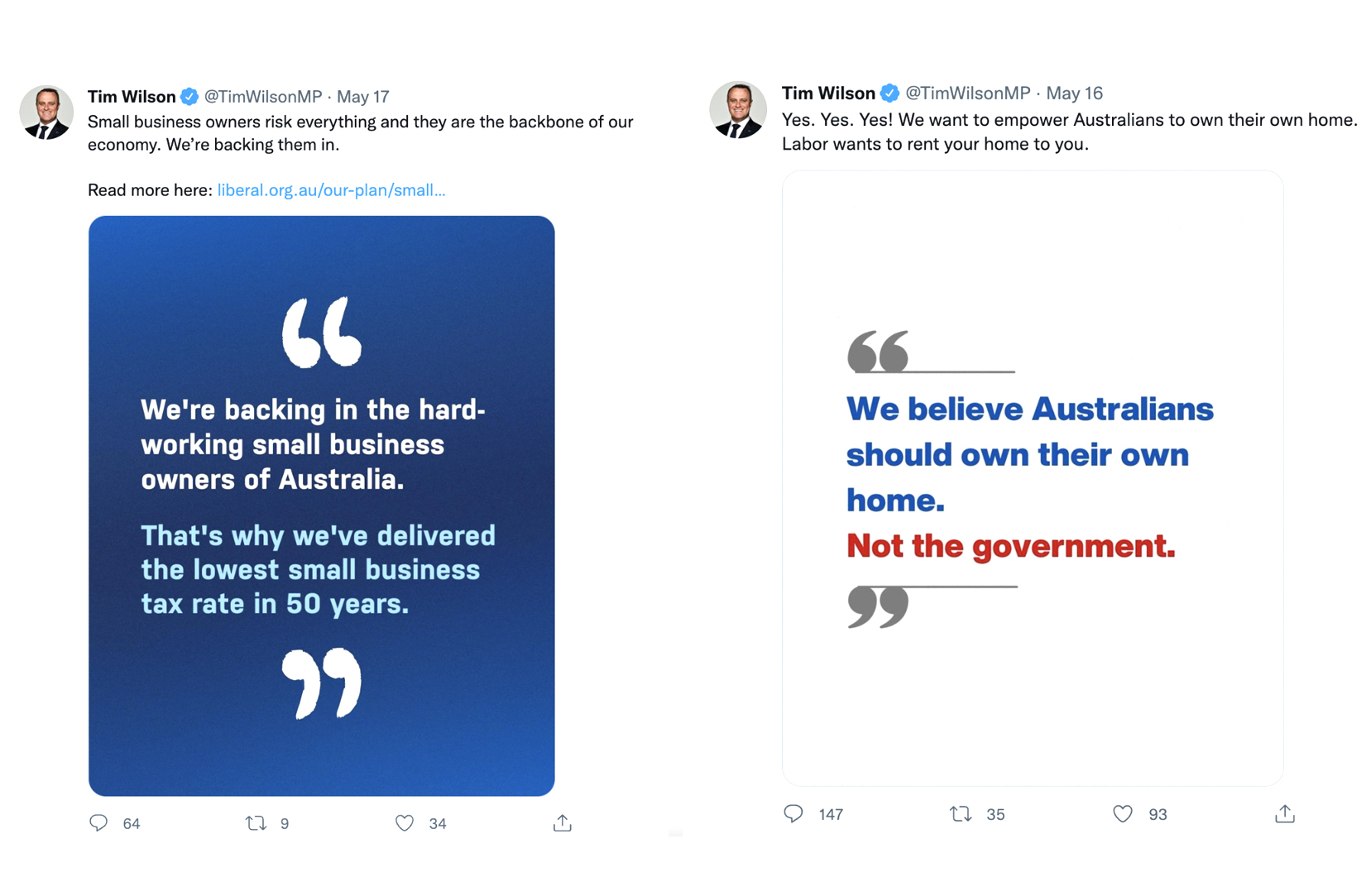
However, in the final days of the campaign, Mr Wilson outlined his plans for the electorate in several posts to Facebook. These referred essentially to multi-million-dollar grants to support sporting clubs and parks with construction and restoration works. These posts did not generate significant engagement, with each registering fewer than 80 impressions.
Unlike Mr Frydenberg in Kooyong, Mr Wilson made some effort to compete with his opponent on the issue of climate change. The posts again failed to generate significant engagement, with recorded impressions of each well below 100.
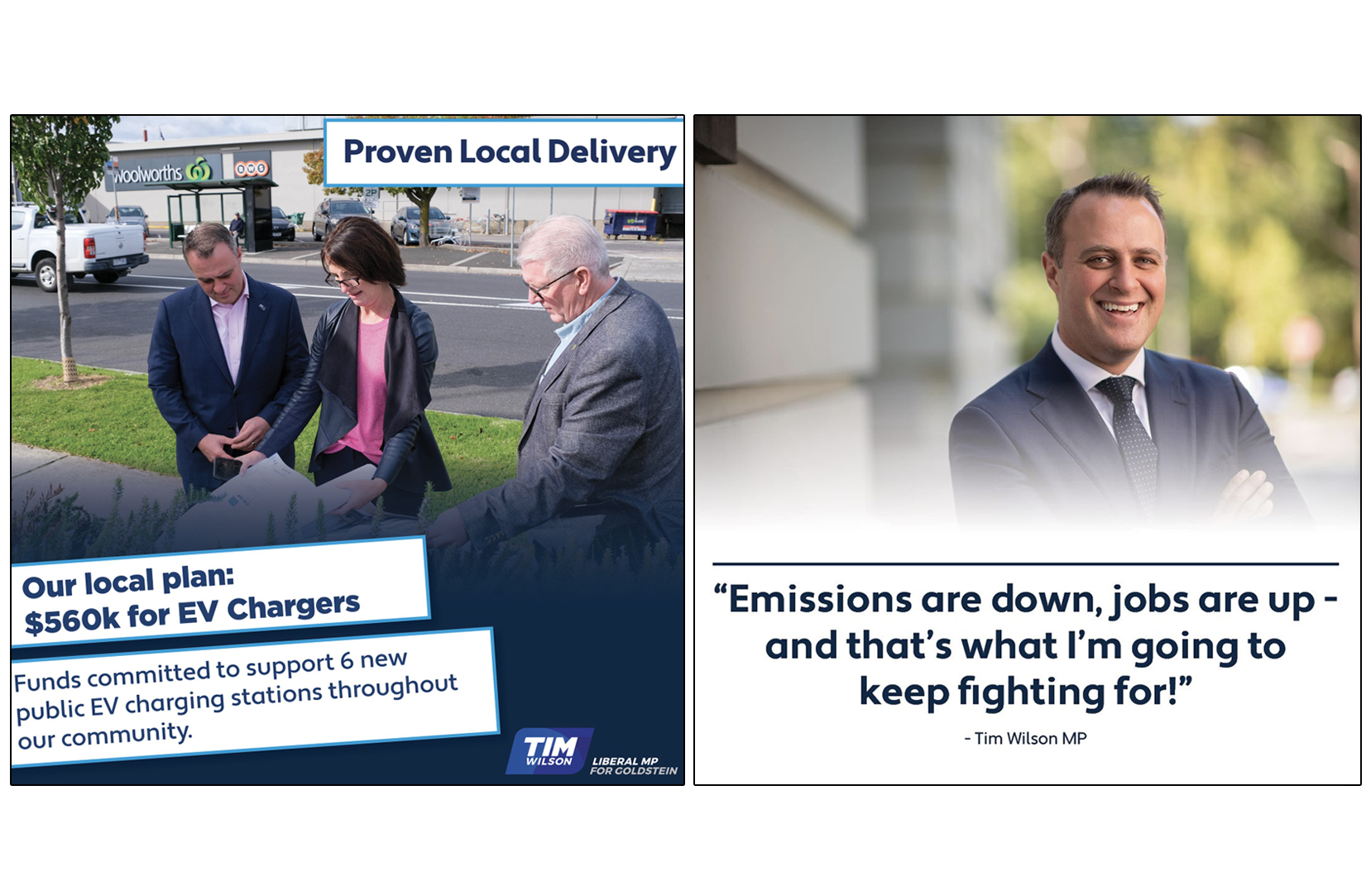
In many of his posts, Mr Wilson adopted the Liberal Party mantra of labelling Ms Daniel a “fake” or “so-called” independent, while casting many of her supporters as “outsiders” who did not reflect Goldstein’s values.
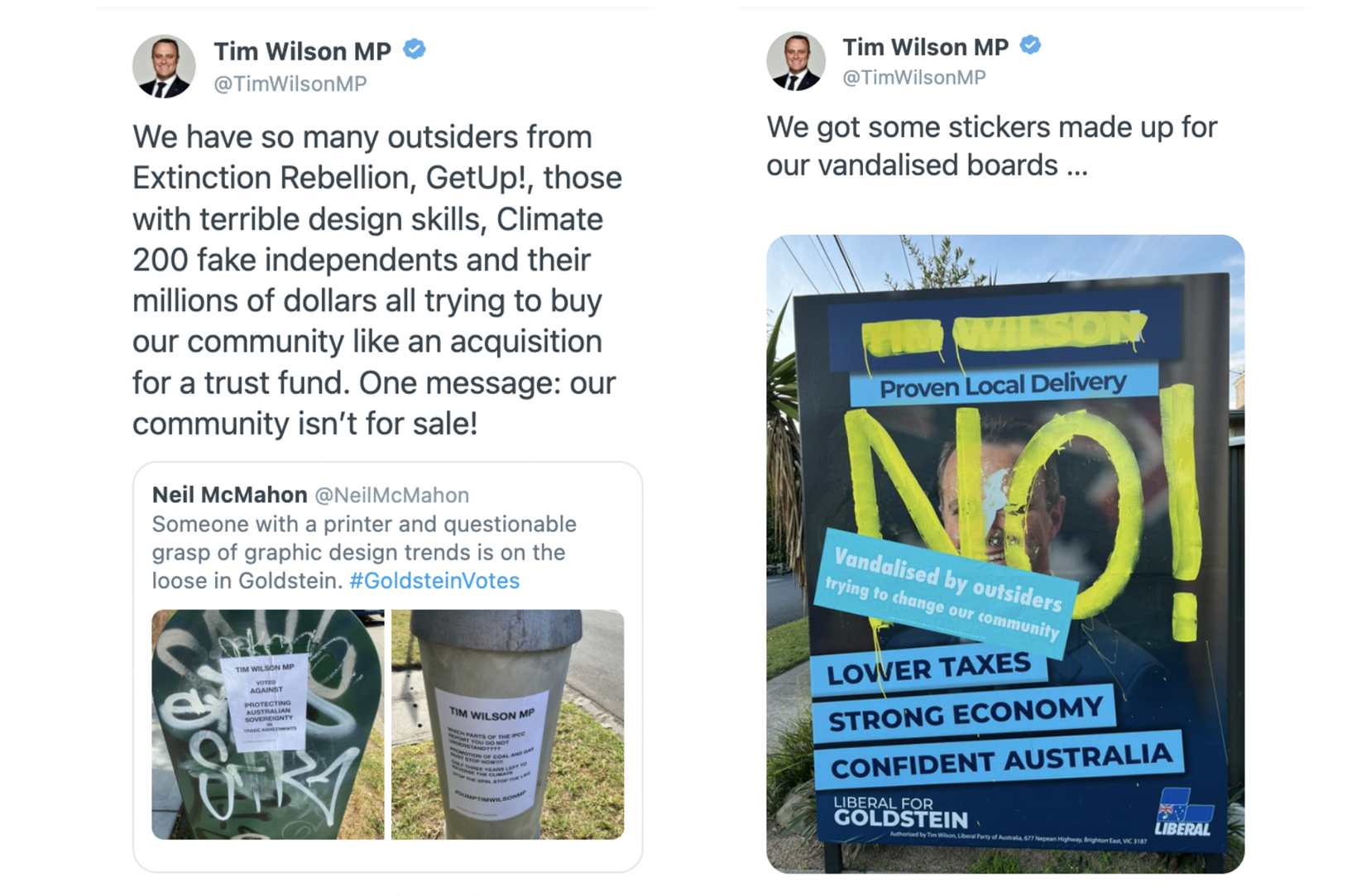
While Mr Wilson’s “anti-independent” posts drew higher levels of engagement from Twitter and Facebook users than his posts on other topics, they also attracted criticism.
This was evidenced by the significant number of replies and “quote tweets” (which allow users to embed their own comments before sharing with others), compared to the number of retweets, suggesting the content was being qualified rather than simply passed on to others.
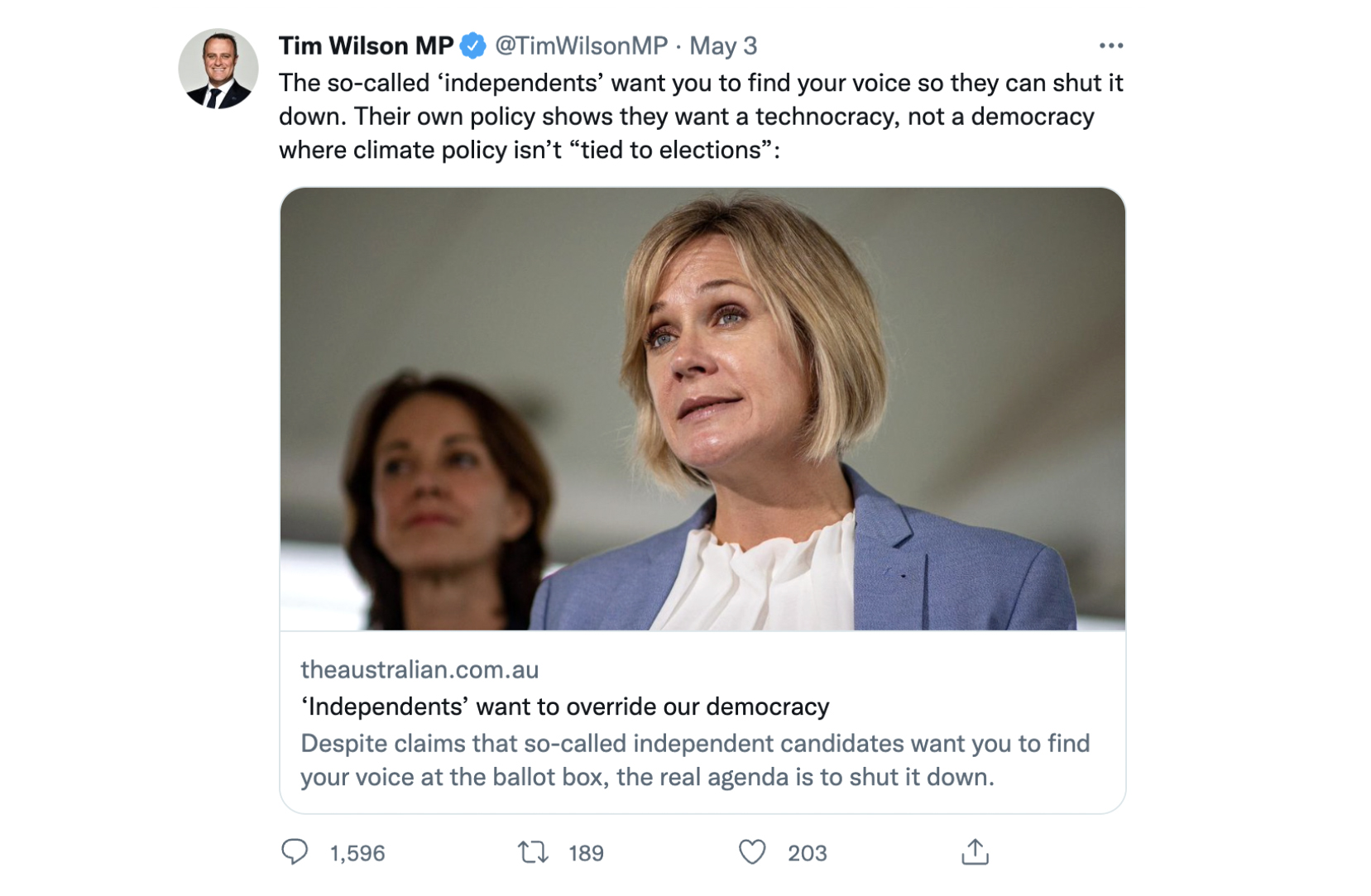
Ms Daniel, with the support of young recruits, led a community-focused social media campaign underpinned by positive messaging. She rarely engaged with Mr Wilson’s accusations online, with the one exception coming towards the end of the campaign (see below).
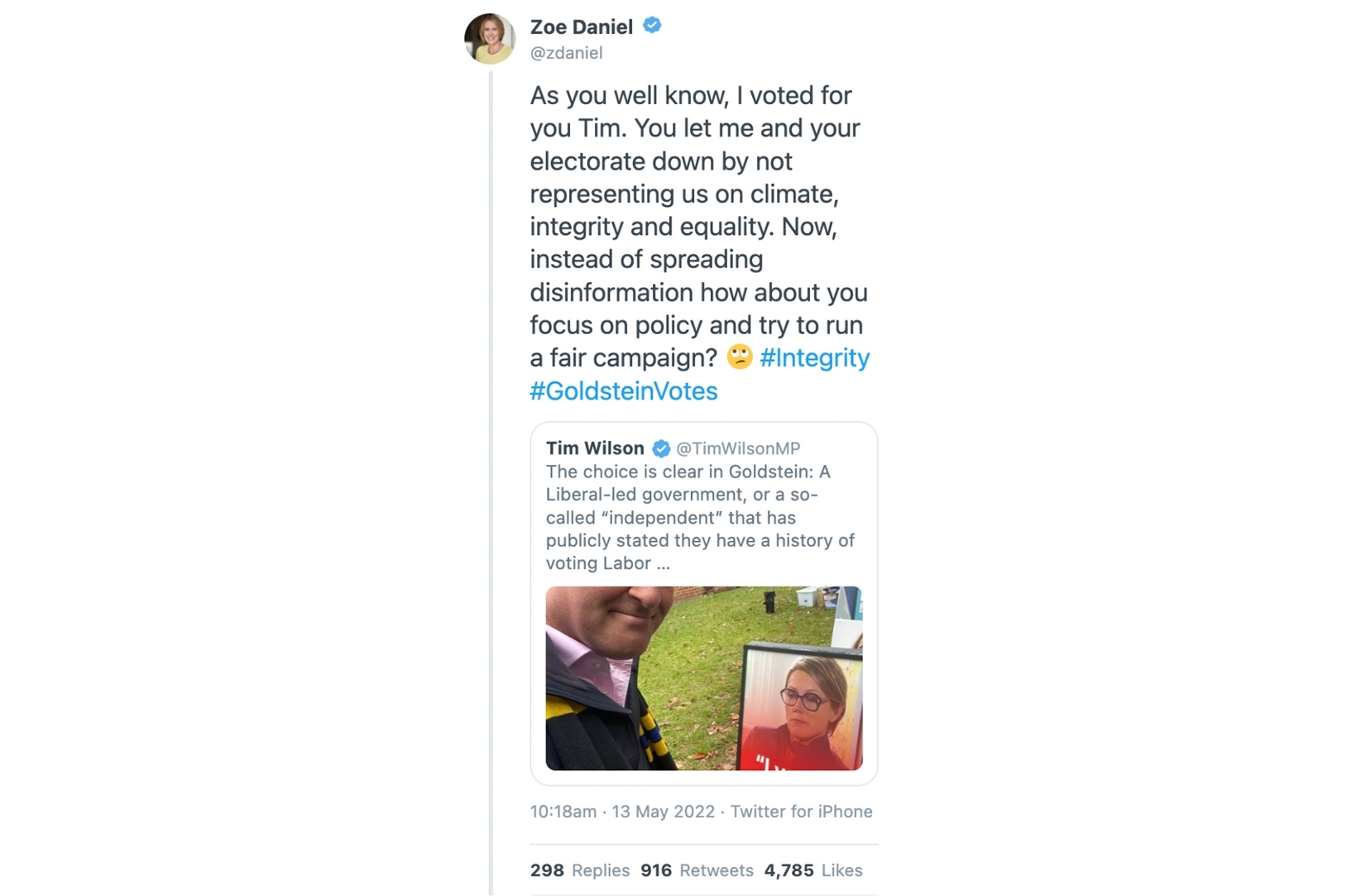
FactLab identified several strategies used by Ms Daniel and her team to boost social media engagement and the reach and impact of her messaging across Goldstein. This was in similar fashion to the social media campaign of fellow independent candidate Dr Monique Ryan in Kooyong.
Ms Daniel delivered messaging that targeted voters dissatisfied with what they perceived as Morrison government inaction on climate change, gender equality and integrity in politics.
She posted messages dozens of times each day, using the catchcry “Same isn’t safe” to imply that retaining the status quo in Goldstein did not amount to a safe course of action given the pressing issues facing Australia. Variations included “same isn’t safe for equality” and “same isn’t safe for climate change”.
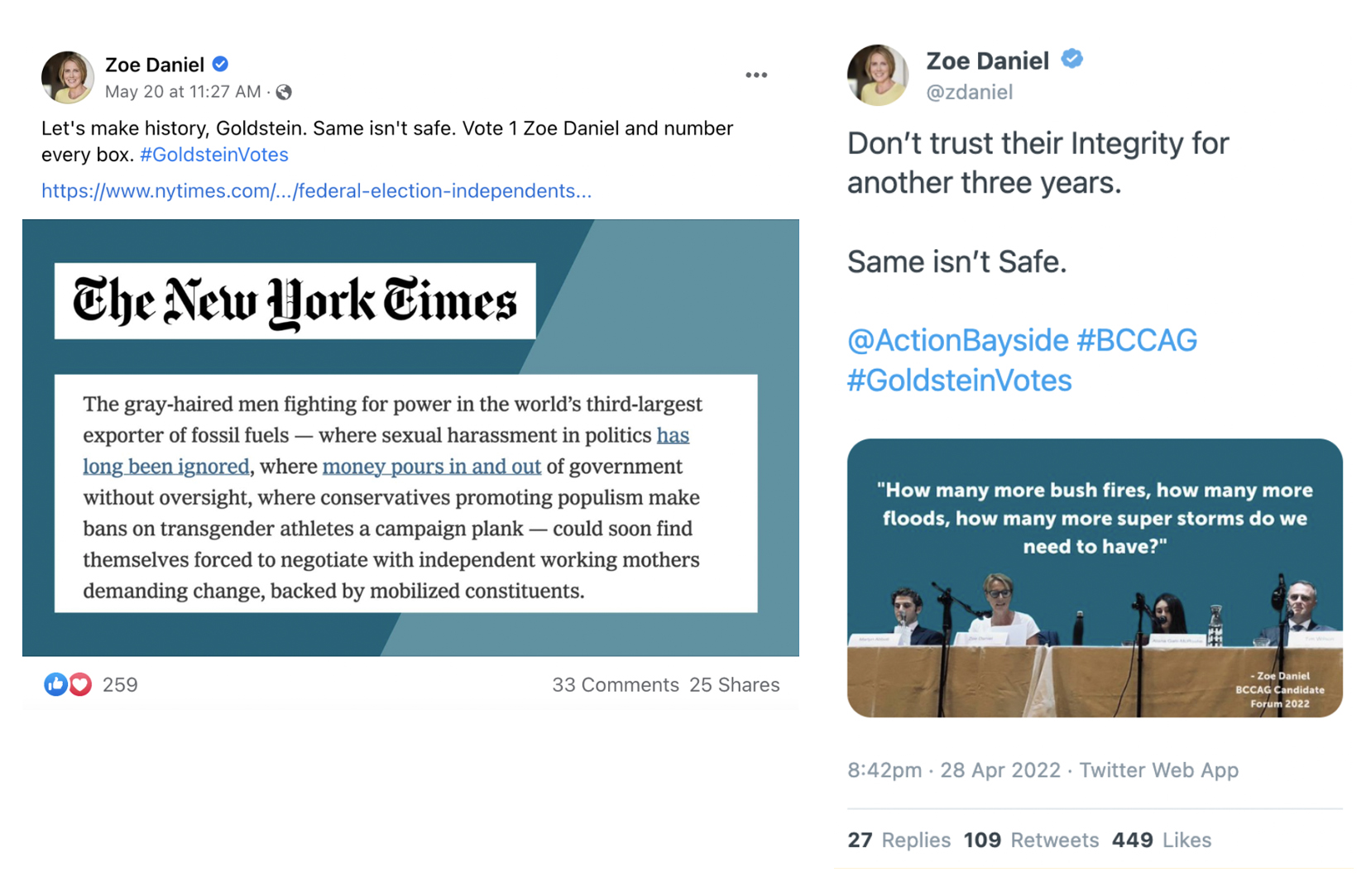
Notably, in most of her Facebook ads and campaign social media posts, Ms Daniel delivered a recorded piece to camera to promote her policy platform.
This was a low budget – but highly effective – way to convey her message in terms of reach and impact. On Twitter, her piece to camera videos were viewed more than 100,000 times in the month leading up to the election, with the best performing videos registering 26,700 views, 19,100 views and 15,900 views. These videos were retweeted a combined 490 times. With fewer followers on Facebook, the videos did not generate as much engagement, with only around 2,000 views per post.
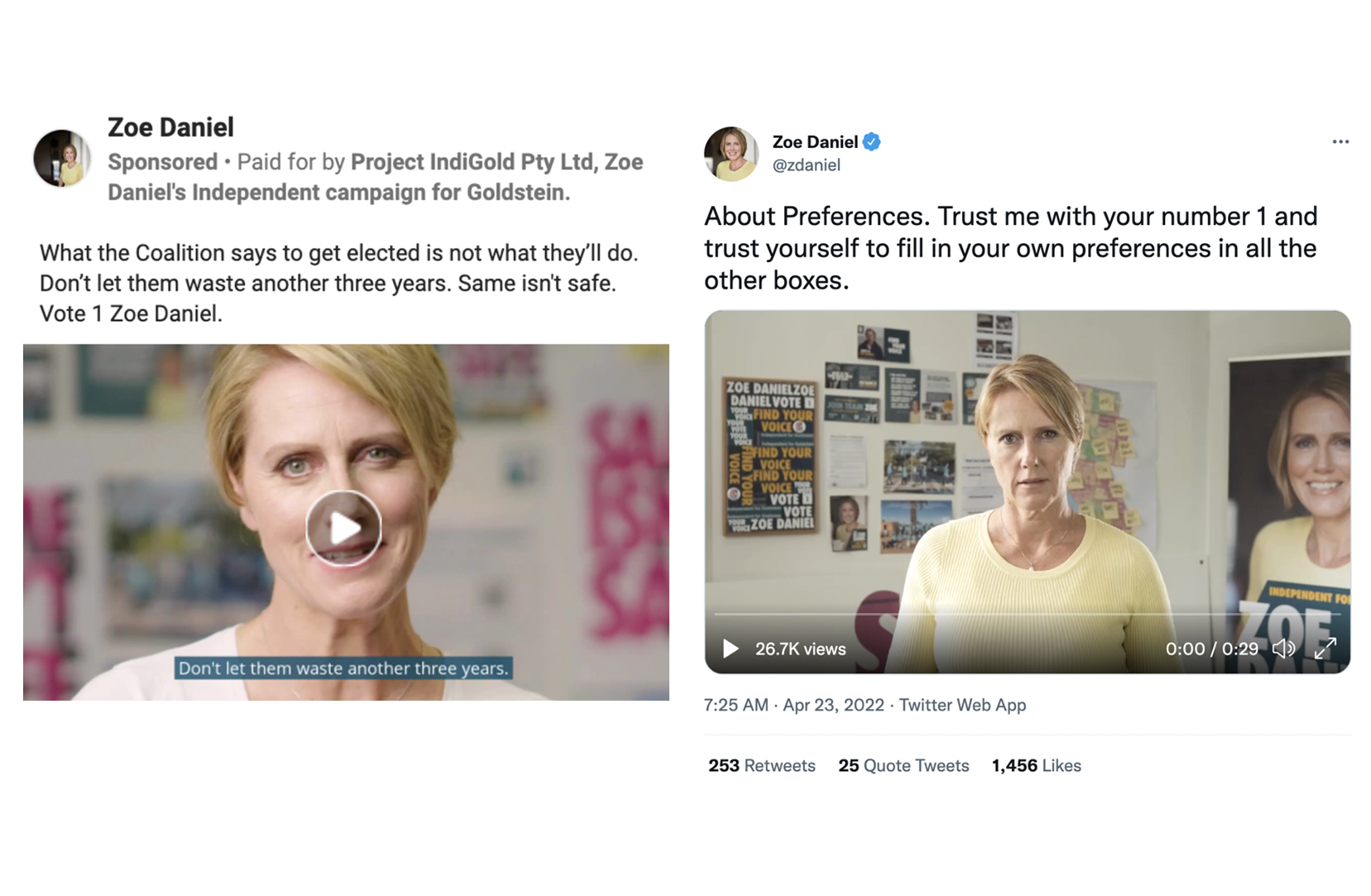
Ms Daniel’s use of video messaging distinguished her campaigning from that of Dr Ryan, who used mostly text and images to promote her agenda.
Ms Daniel also regularly amplified the voices of her supporters through video “voter profiles”, allowing her to promote and build momentum for her campaign. The success of this strategy was reflected in the thousands of views each video received.
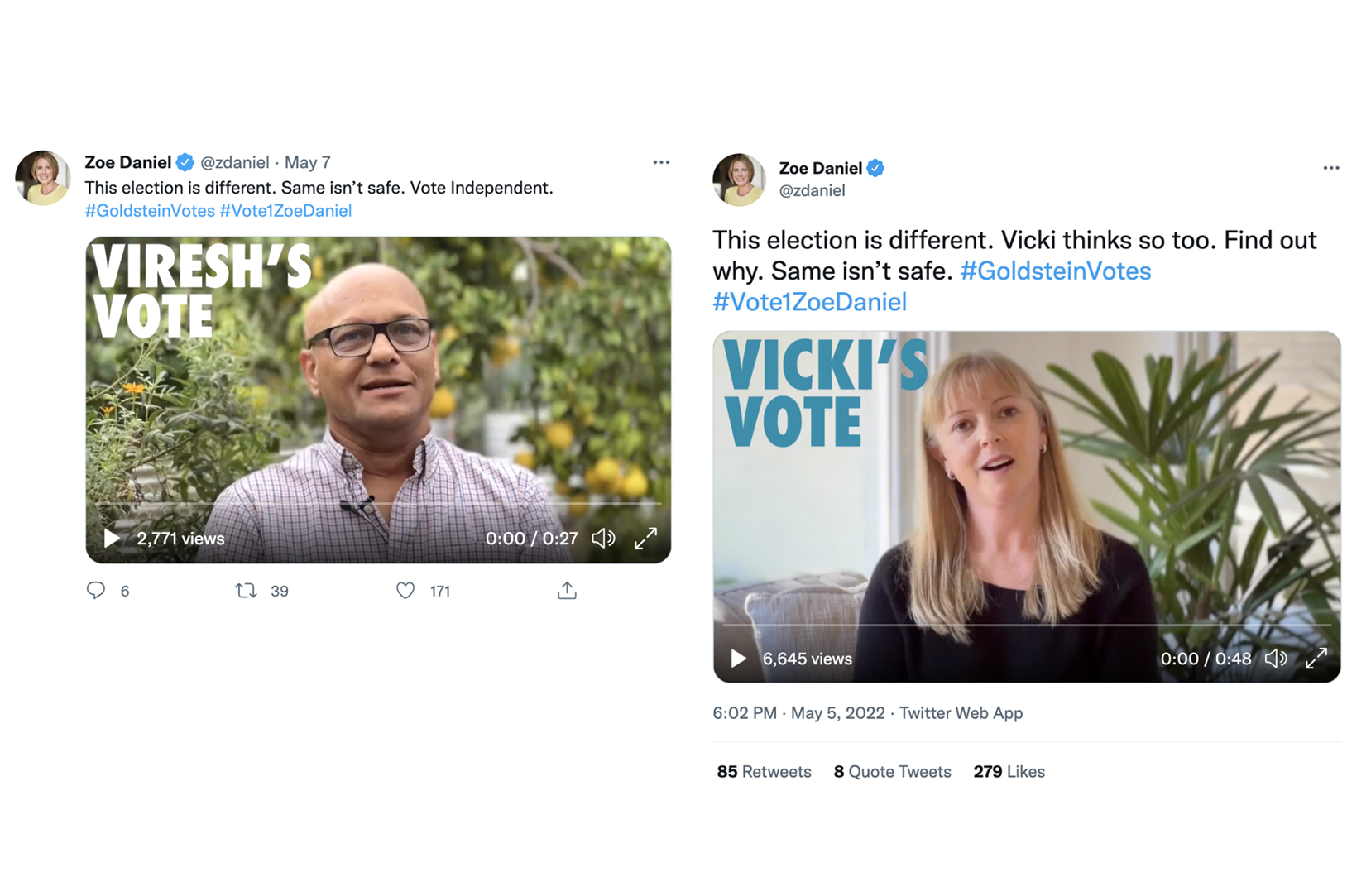
She also made effective use of hashtags to expand the reach of her messaging. All her social media posts were accompanied by #Vote1ZoeDaniel, #TeamZoe and #ZoeForGoldstein.
This strategy gave Ms Daniel significant reach, with each hashtag generating hundreds of posts from her supporters across Facebook, Twitter, Instagram and TikTok. The result, however, fell short of that of Dr Ryan, whose use of hashtags generated thousands of posts from her supporters.
Notably, it was young voters who gave Ms Daniel’s campaign its bite.
Once the election was called, she released a campaign video urging first-time voters to register.
On social media, Ms Daniel’s heavily promoted her “Gen Zoe” movement, which directly targeted voters aged 18 to 35.
She tapped the climate change anxieties of young Australians by urging them to join her movement to give voice to their concerns on issues that also included equality, integrity and the treatment of refugees.
Ms Daniel launched a Gen Zoe campaign video, a Gen Zoe web page and 32 Facebook ads promoting the movement.
The campaign video was shared across all social media platforms and generated significant engagement, with 2,772 views on Twitter, 2,767 views on TikTok and 1,700 views on Facebook.
Across all platforms, Ms Daniel and her team regularly promoted Gen Zoe community events, including public forums, rooftop movie nights and community meetups.
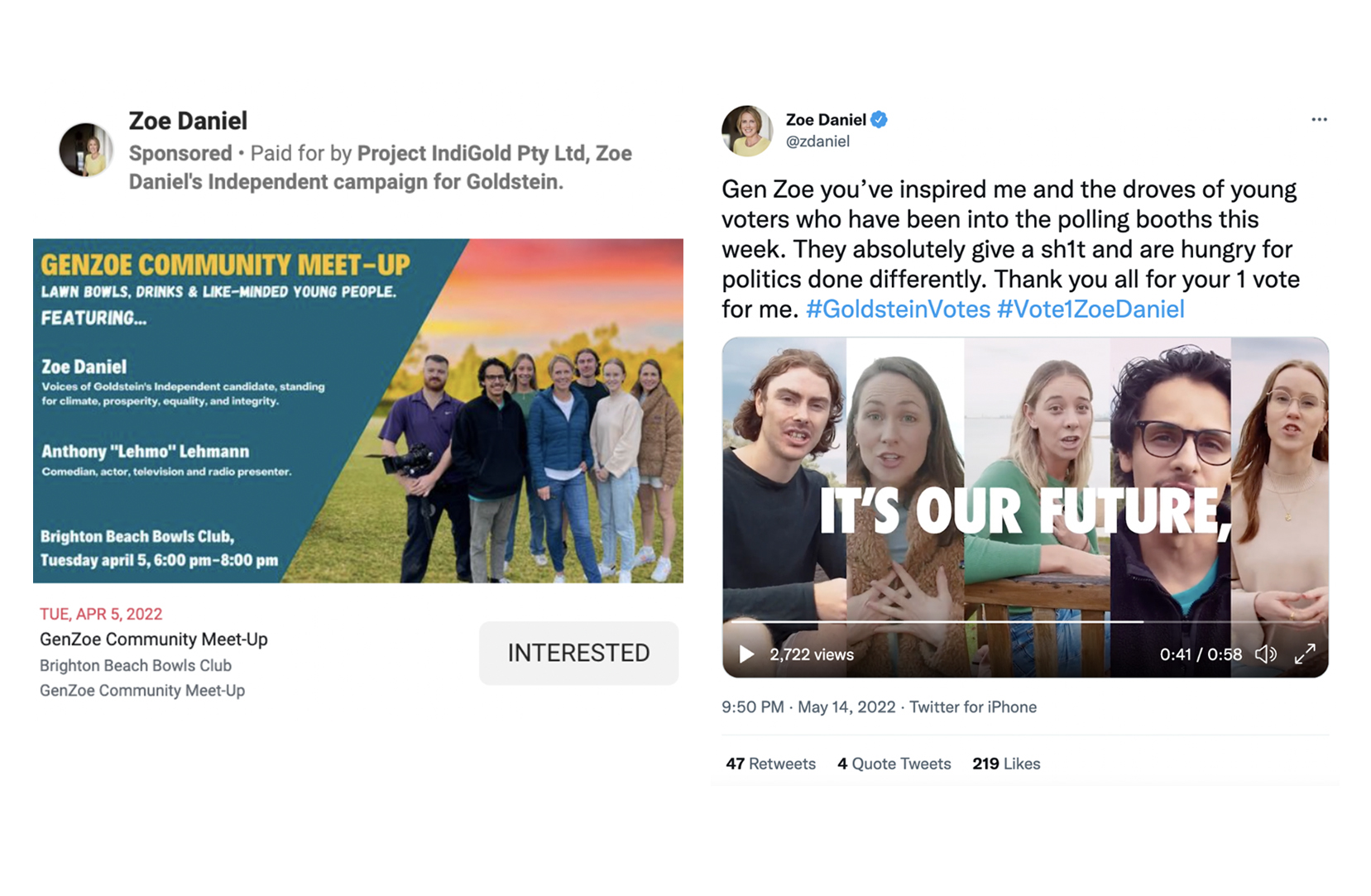
In the lead up to the election, she also established a Team Zoe For Goldstein TikTok page to attract younger voters although its following fell well shy of that of Dr Ryan, with the former’s page garnering just 93 followers and 380 likes. Ms Daniel posted five videos, which drew a combined 12,000 views.
The nub of the competing campaigns
FactLab analysed the reach of the social media campaigns of the candidates for the period April 1 to May 20.
Ms Daniel was far more active on Twitter than Mr Wilson, tweeting or retweeting 485 times compared to his 166 tweets or retweets.
However, her reach was extended considerably by others who retweeted her message.
Ms Daniel’s top 10 performing tweets drew retweets ranging from 428 to 2828. However, FactLab could only identify one tweet of Mr Wilson that generated more than 100 retweets.
Tik Tok
While Ms Daniel’s Tik Tok page only attracted 91 followers, she still had an impact on the platform through hashtags. Videos containing #zoedaniel and #teamzoe recorded almost 500,000 views.
Advertising
The amount the Goldstein rivals spent on online campaign advertising paled in comparison to the amount spent by candidates in Kooyong and Wentworth (NSW).
Candidate |
Facebook ads (min spend) |
Google & YouTube (min spend) |
Monique Ryan (Kooyong) |
$157,800 |
$119,550 |
Josh Frydenberg (Kooyong) |
$202,800 |
$83,550 |
Allegra Spender (Wentworth) |
$97,500 |
$65,550 |
Dave Sharma (Wentworth) |
$96,500 |
$50,400 |
Zoe Daniel |
$16,400 |
$0 |
Tim Wilson |
$1,300 |
$150 |
Between December 2021 and May 21, Ms Daniel spent at least $16,400 exclusively on Facebook campaign advertising, whereas Mr Wilson spent just $1450 on YouTube, Google and Facebook ads.
According to QUT's PoliDashboard Facebook Political Ads Module, Ms Daniel spent between $16,400 and $43,530 on Facebook ads, which received more than 896,000 impressions.
Mr Wilson, on the other hand, spent between $1300 and $7141 on Facebook ads, which received more than 166,000 impressions.
According to Google Transparency Report on Political Advertising in Australia, he also spent $150 on Google and YouTube campaign ads.
How far did these election ads reach?
Ms Daniel’s Facebook ads reached a significantly larger audience than those of Mr Wilson.
One of Ms Daniel’s most impactful Facebook ads recorded between 100,000 and 150,000 impressions, with another recording between 45,000 and 50,000 impressions.
The most significant Facebook election ad uploaded by Mr Wilson only recorded between 15,000 and 20,000 impressions.


Acknowledgement of Country
RMIT University acknowledges the people of the Woi wurrung and Boon wurrung language groups of the eastern Kulin Nation on whose unceded lands we conduct the business of the University. RMIT University respectfully acknowledges their Ancestors and Elders, past and present. RMIT also acknowledges the Traditional Custodians and their Ancestors of the lands and waters across Australia where we conduct our business - Artwork 'Sentient' by Hollie Johnson, Gunaikurnai and Monero Ngarigo.
More information